DR providers are putting their personal stamp on IR offerings
With the flood of global IPOs having slowed to a trickle, the four major DR providers – BNY Mellon, JPMorgan, Citi and Deutsche Bank – have started exploring new ways to help existing and prospective clients.
And one increasingly popular way of differentiating a DR program and gaining new business is through honing the IR advisory services on offer. Here, the DR provider heavyweights explain what makes their offering stand out.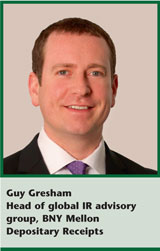 Helping clients with heavy lifting in the IR zone
Helping clients with heavy lifting in the IR zone
Everyone knows the past five years have wrought dramatic changes at broker-dealers and across the entire financial services industry. For public companies, there are simply fewer investor conferences and IR-oriented services for broadcasting a compelling story to investors, says Guy Gresham, head of the global IR advisory group for BNY Mellon’s DR division.
For this reason, Gresham hopes to provide real and concrete support for BNY Mellon’s roughly 1,200 DR clients. Gresham and others from his team will sit down with DR clients annually – or even quarterly – to discuss upcoming IR activities. ‘We’d like to identify areas where we can embed ourselves into an investor relations program and deliver on tangible projects,’ he explains.
Born in New Zealand, Gresham was a policy officer at the Australian Securities & Investments Commission before moving to the US nine years ago. He spent his first two years in New York City working at IR consultants Allen & Caron and the Ruth Group. There, he had the opportunity to work closely with all four of the major DR providers.
Because of his years in IR consulting, Gresham knows what practical assistance IR professionals need. For clients embarking upon a roadshow, BNY Mellon will review the itinerary and conference scheduling, suggesting additional targets for companies to visit. Gresham also sits down with clients on an annual basis and performs a full investor analysis, identifying good targeting candidates and facilitating engagement with them.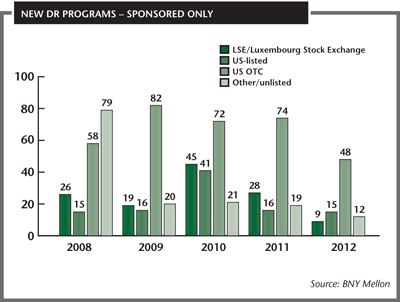
In addition, BNY Mellon has conducted a large, annual investor relations survey for the past eight years; in 2012, for instance, the firm gathered information from 800 companies in 59 countries.
By amassing this compendium of investor relations practices, the company can help DR clients benchmark their own IR activities against peers.
‘We break down the information for our clients, and say, This is how much time your CEO is spending on the road, and this is the average for your sector and market cap,’ explains Gresham. When a company falls short of best practices, BNY Mellon can suggest ways to improve.
The same goes for disclosure information: by showing clients what leading companies are doing, Gresham can make concrete recommendations for how issuers with DR programs can achieve world-class standards of transparency and open communications.
BNY Mellon counts Toyota, GlaxoSmithKline, China Telecom, Petrobras in Brazil and Gazprom in Russia as clients. Gresham has found that DR clients have begun to voice new aspirations, too.
‘Some of our clients coming from the emerging markets don’t want to be perceived as an emerging markets player – a Brazilian player or a Russian player – but as global participants in their particular sector,’ he says. ‘Ultimately, DRs are a great vehicle for building additional connectivity in the market. But they’re only a vehicle.’
What truly matters is developing a DR program that’s integrated into a broader capital markets strategy – a feat BNY Mellon can help issuers achieve. ‘It’s all well and good to provide advice,’ Gresham says. ‘We want not only to provide guidance on what companies could be doing in terms of IR, but also to identify areas where we could be doing the heavy lifting for them.’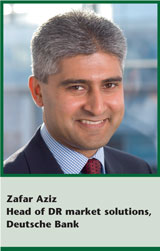 No one-size-fits-all IR solutions
No one-size-fits-all IR solutions
When 30 executives from one of Deutsche Bank’s larger, NYSE-listed Chinese DR clients found themselves in Oxford in the UK with a little spare time, they asked Zafar Aziz, head of DR market solutions at Deutsche Bank, to give a presentation on the basics of IR.
‘I put together the presentation, brought in a translator – I’m not a Mandarin speaker – and we accommodated the request at very short notice,’ Aziz recalls. ‘The next day, we might be called on by a DR client doing a roadshow in Texas to supply a list of the largest, ADR-oriented investors in the Dallas region. We adapt to the different needs of our clients.’
Not knowing what the next investor relations question will be doesn’t bother Aziz. The director, who has headed the DR market solutions team at Deutsche Bank for the past two years, is comfortable tailoring IR solutions to individual clients because of his long history working beside IR professionals.
Before coming to Deutsche Bank, he was employed by a DR competitor, and earlier still, he worked at merchant bank SG Warburg, where his team provided IR advice to corporate brokerage clients.
Aziz is committed to fully understanding the regulations, stock exchange requirements and nuances of ADR and global DR trading, all of which influence a company’s IR practices.
He points out that something as seemingly simple as changing the ratio of one’s ADRs to ordinary shares needs to be clearly communicated to shareholders. Similarly, a company that upgrades from a Level I ADR to a full US listing will want to revisit its whole approach to investor relations to capitalize on the company’s new status.
Deutsche Bank, which manages close to 1,000 DR clients globally, has clients such as BASF in Germany, Tesco in the UK, Severstal in Russia and Heineken in the Netherlands. The firm sees wide variations in IR strategy, depending upon the size of an issuer.
‘You may have a large-cap company that has 10-plus people in its IR team,’ says Aziz. ‘But you might also have companies that have just had their IPO with the CFO doing investor relations. You need to do a lot of handholding and give them a lot of advice.’
That said, Aziz emphasizes education and training for Deutsche Bank’s entire DR roster. ‘IR is a fast-moving industry and you have to be plugged in to keep pace,’ he says.
For this reason, Deutsche Bank has sponsored the professional development course for the IR Society in the UK for the past four years, as well as participating in events sponsored by NIRI and the investor relations associations in Germany and Brazil.
‘What differentiates Deutsche Bank is that we provide investor relations services in a customized way. We don’t take the one-size-fits-all approach,’ says Aziz. ‘And we make sure all IR advice is provided within the context of DRs. My philosophy is: keep it relevant to DRs.’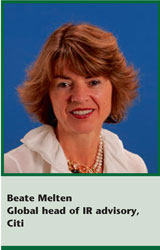 Helping DR clients communicate better on IR
Helping DR clients communicate better on IR
When Beate Melten worked on the investor relations team at a non-US company listing on the NYSE, she witnessed firsthand the monumental challenges involved in moving into an international spotlight. ‘In 1999, high-tech companies were in favor and it was hard for [my former employer] to get attention,’ recalls Melten. ‘I know what it feels like not to be loved by investors.’
Having become global head of IR advisory for Citi’s DR program seven years ago, she uses her experience with a newly public DR listing to help Citi’s roughly 250 DR clients hone their IR skills. ‘There’s resonance when you talk about things you’ve gone through yourself,’ she says.
One way Citi distinguishes itself from other DR providers is by having a worldwide team of IR advisers, all of whom have investor relations backgrounds, says Melten. Although she doesn’t need to educate clients like Samsung, Nokia or TSMC on the finer points of IR, smaller companies fighting for name recognition are eager for the advice.
For instance, Melten often coaches clients on dealing with thorny questions raised by investors. ‘It matters how you deliver your message, how confident you are,’ she says. ‘When there are tough questions, you can’t get fearful
or withdraw.’
Because there are so many companies out there vying for attention, Melten’s key message is always to differentiate oneself. ‘You don’t want investors to look at you as an investment to trade,’ she says. ‘You need to make them look at you as an entity they can invest in – which is different. And you can turn those that bought you to trade into investors – if you do the right follow-up.’
Melten is convinced that IR professionals with overseas listings can learn plenty from one another. Therefore, three years ago, Citi created the IR Academy for Asian companies listing outside their home markets. These gatherings have brought together companies with DR programs in different global locales, including Taiwan and Hanoi.
Citi is also exploring innovative ways for DRs to remain relevant. Specifically, it has developed global depositary notes, which adapt the DR concept to the fixed income market.
‘The DR product has gone through some changes and it continues to evolve,’ Melten concludes. ‘The fact that companies have global aspirations and want access to markets outside their own locality will surely continue. And I believe the ADR and the DR will continue to be products of interest to those with global aspirations.’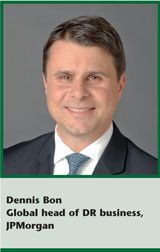 Using resources to innovate
Using resources to innovate
JPMorgan introduced Hong Kong depositary receipts (HDRs) in 2010 – through a listing by Vale, the Brazilian mining giant – and claims the distinction of having created both the first DR in Latin America and the first DR in Asia. Dennis Bon, global head of the bank’s DR business, maintains that it is innovations like these that distinguish JPMorgan from other DR providers.
‘Focusing on large issuers is central to our strategy,’ says Bon. ‘With fewer clients, we are able to give the highest level of attention and expertise to our DR clients, as opposed to spreading ourselves thinly across many of them.’ Of approximately 250 DR clients, many are household names – from BP in the UK to Sanofi in France, Sony in Japan, Vale in Brazil and Rosneft in Russia.
A native of Canada, Bon is well positioned to use the bank’s diverse resources because he’s served in many different capacities at JPMorgan. Prior to joining the DR team a year ago, he spent four years as global head of strategy and M&A in New York and four years as head of international business development in London; earlier still, he was an M&A banker at ABN Amro in Amsterdam.
Although Bon hasn’t personally worked as an IR professional, many of the individuals in his DR team have. He points out that a BP or a Vale would have a large, well-staffed IR team, and so the focus would be on delivering new, high-quality investors to such companies. For a more recent issuer, JPMorgan would deliver IR training and education.
‘The majority of DR growth is being driven by the BRIC economies of Brazil, Russia, India and China, largely Russia. There is less investor relations knowledge in these markets, so we provide more advice and support to clients there,’ says Bon.
In addition, the company continually keeps DR clients abreast of emerging IR trends, investor views and capital market developments. ‘In an age of global austerity, companies are making ever-greater use of external service providers,’ Bon points out. ‘In this regard we provide strong support to DR clients.’
In the future, Bon remains bullish on the prospects for DRs. He points out that JPMorgan is ‘seeing more pick-up from a broader range of investors than ever before.’ He also emphasizes that issuers in countries such as Mongolia and Iraq are inquiring about listing overseas.
‘More and more frontier markets like these will take a larger role in terms of DR issuance over time,’ he predicts. ‘DRs play a key role in helping companies access capital overseas, and therefore the product will continue to be a growing and important business for our bank.’










